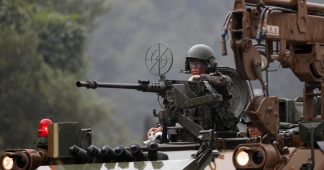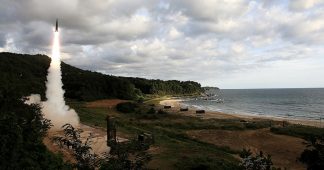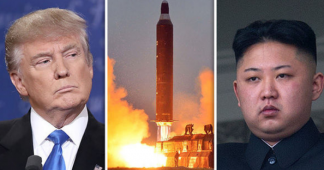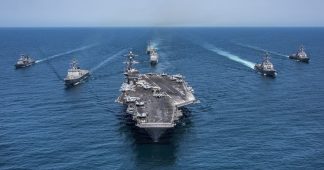False alarm of incoming missile in Japan
By Peter Symonds
Just days after a false alert in Hawaii about an incoming missile, the Japanese public broadcaster NHK panicked the public yesterday with an incorrect warning about a missile being launched from North Korea. A message correcting the error was sent out five minutes later.
Authorities in both countries blamed individuals for making a mistake. However, the two false alarms about a missile attack are not purely coincidental. They are a product of the extreme tensions on the Korean Peninsula, for which the United States and its ally Japan are chiefly responsible.
NHK published an alert on its web site and sent out a warning to mobile phones and via Twitter on Tuesday that read: “North Korea appears to have launched a missile. The government urges people to take shelter inside buildings or underground.”
Five minutes later came a correction and an abject apology from the NKH on-line host. “This happened because equipment to send a news flash onto the Internet had been incorrectly operated,” the announcer said. We are deeply sorry.” No further details have been provided.
The very fact that two false alerts can take place in less than a week, after decades in which no such panics took place, highlights the advanced preparations for war with North Korea, and also with major nuclear-armed powers such as China and Russia. Surveillance and warning systems are being built, or revived from the Cold War and extended, as part of a rapid US-led military build-up in Asia.
In November, authorities in Hawaii, where the US military’s Pacific Command is based, announced monthly testing of the Cold War-era system that blares out an Attack Warning Tone through sirens. The Emergency Management Agency said it would update the population on its actions to “prepare our state for a nuclear threat.”
Under the government of Prime Minister Shinzo Abe, Japan also has ramped up its civil defence apparatus and instigated civilian drills to prepare for a missile attack. Abe has exploited the confrontation with North Korea to justify the remilitarisation of Japan and his push to eliminate legal and constitutional constraints on the use of the armed forces.
It cannot be completely ruled out that either or both of the false alarms were orchestrated deliberately to create a climate of fear and apprehension about the “North Korean threat.” Throughout the past year, a relentless propaganda campaign has been conducted in both countries to paint the small, impoverished country with its limited nuclear arsenal as the greatest international menace.
In fact, for all its bluster, the Pyongyang regime, which confronts the world’s most powerful military armed with thousands of nuclear warheads, has always insisted that it requires nuclear weapons as a means of defence. The Trump administration, however, has declared it will not permit North Korea to have a nuclear missile capable of hitting continental America and repeatedly warned it will use all means, including military attack, to prevent that.
Trump’s own bellicose threats to rain “fire and fury” on North Korea and “totally destroy” the country of 25 million people demonstrate that the US is prepared to use nuclear weapons to achieve its end. At the same time, the US is ratcheting up its efforts to apply “maximum pressure” on Pyongyang to capitulate to Washington’s demands to destroy its nuclear weapons, missiles and associated facilities, and submit to highly intrusive inspections of its military and industries.
US Secretary of State Rex Tillerson yesterday jointly convened with Canadian Foreign Minister Chrystia Freeland a gathering in Vancouver of 20 nations to discuss ways of intensifying the pressure on North Korea. Both China and Russia refused to attend, declaring the event to be unrepresentative and counterproductive.
In their opening remarks, foreign ministers noted recent talks between the two Koreas and the participation of North Korea in next month’s Winter Olympics in South Korea. However, all of them insisted North Korea had to denuclearise and ruled out any easing of the sanctions that are crippling its economy.
Tillerson reiterated that the US “will not accept a nuclear-armed North Korea” and called for tougher measures. “We have to increase the costs of the regime’s behaviour to the point that North Korea must come to the table for credible negotiations,” he said. North Korea is already the most diplomatically and economically isolated country in the world, with bans on most of its exports and heavy restrictions on the import of oil and other goods.
Tillerson specifically called for nations to increase the maritime interdiction of ships conducting illicit trade with North Korea. The US may well be pushing for some form of naval blockade—a measure that goes well beyond last month’s UN Security Council resolution calling for the seizure of such vessels in port.
Canada’s top general Jonathan Vance hinted that the search and seizure of vessels on the high seas was being discussed. He declared that he has “the military capacity inside the Armed Forces” to participate in any efforts to enforce the sanctions against North Korea. A naval blockade would itself be a provocative act of war that could precipitate a wider conflict.
Alongside US demands for tougher measures, the US is accelerating preparations for a war of aggression, not defence, against North Korea in the months ahead. While the US has postponed major joint exercises with South Korea for the duration of the Winter Olympics, the Pentagon is stepping up military drills at home.
Congressman Mac Thornberry, who chairs the House Armed Services Committee, told reporters yesterday: “The administration is very seriously looking at what would be involved with military options when it comes to North Korea.” He added that the training underway was “very serious.”
A lengthy New York Times article yesterday was entitled “US military quietly prepares for last resort: War with North Korea.” It reported that “the scope and timing of the exercises suggest a renewed focus on getting the country’s military prepared for what could be on the horizon with North Korea.
“At Fort Bragg in North Carolina last month, a mix of 48 Apache gunships and Chinook cargo helicopters took off in an exercise that practiced moving troops and equipment under live artillery fire to assault targets. Two days later, in the skies above Nevada, 119 soldiers from the Army’s Airborne Division parachuted out of C-17 military cargo planes under cover of darkness in an exercise that simulated a foreign invasion.
“Next month, at Army posts across the United States, more than 1,000 reserve soldiers will practice how to set up so-called mobilisation centres that move military forces overseas in a hurry.”
The article pointed out that the US was sending more Special Forces troops to South Korea during the Olympics, in what “some officials said ultimately could be the formation of a Korea-based task force similar to the types that are fighting in Iraq and Syria.”
The most ominous sign that the US is preparing for a catastrophic war with North Korea is the build-up of strategic bombers at its bases on Guam in the western Pacific. CNN reported yesterday that the US Air Force has deployed six more B-52 bombers to Guam’s Anderson Air Force Base to join three B-2 stealth bombers sent earlier this month to replace B-1 bombers. Unlike the B-1, the B-52 and B-2 bombers are equipped to carry nuclear weapons.











